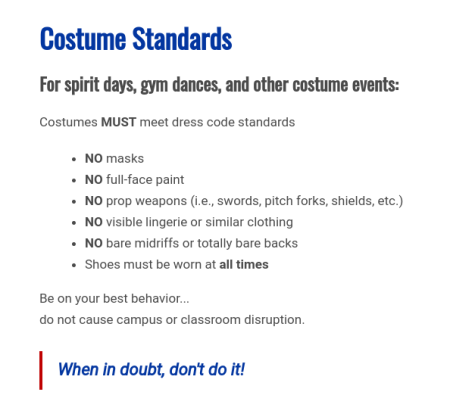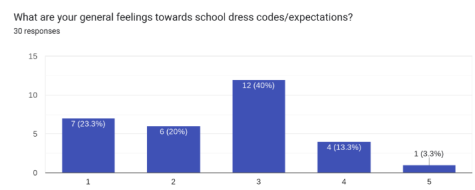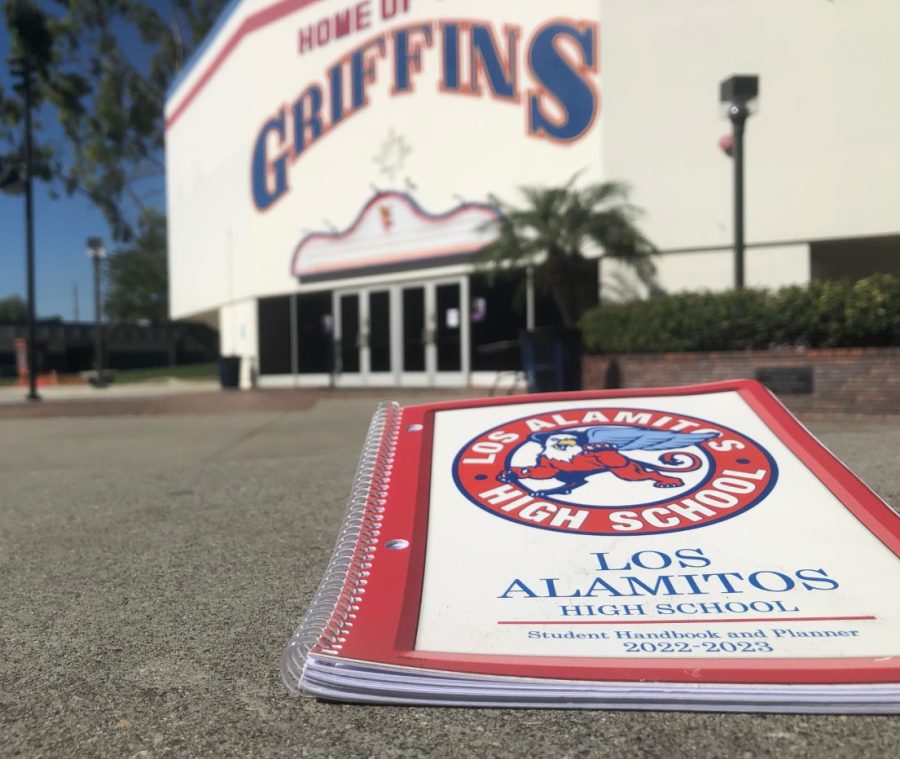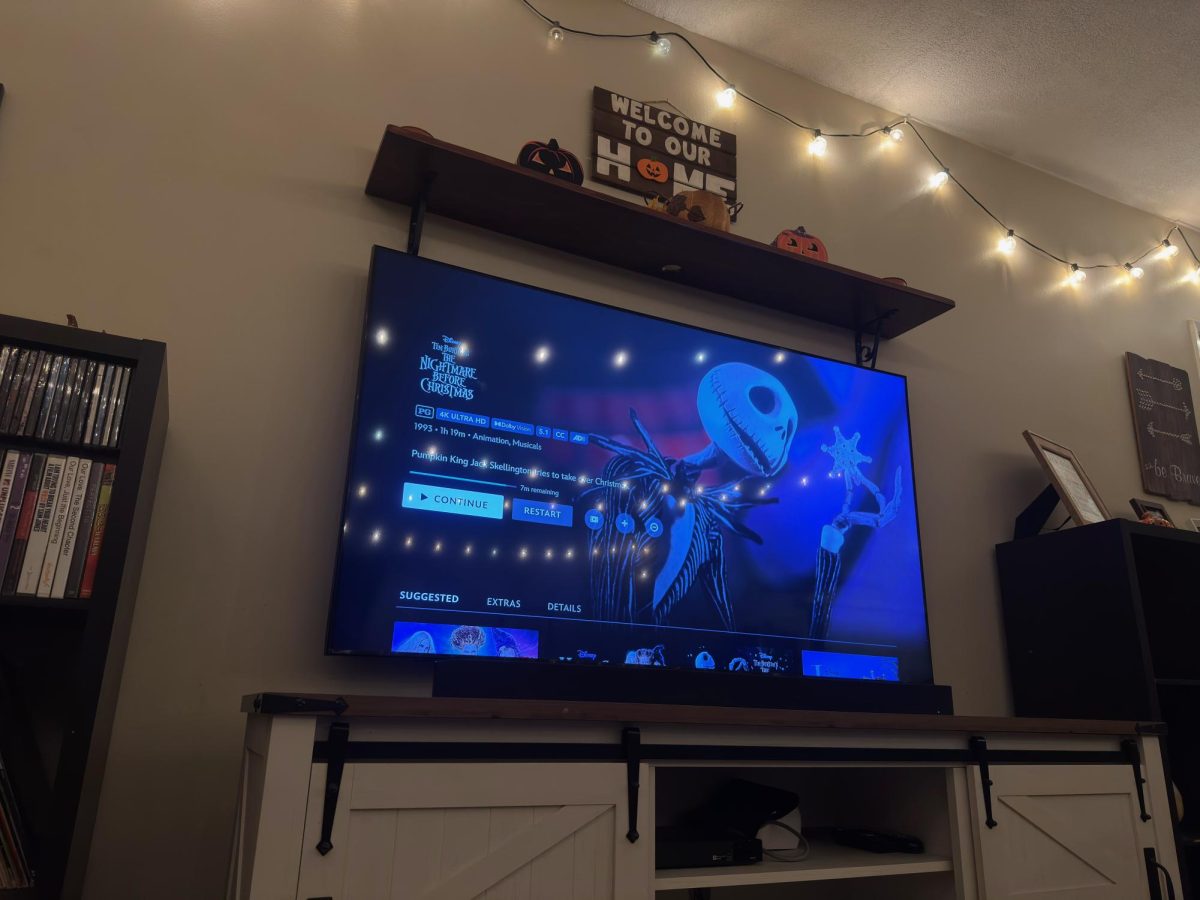School dress expectations: The nationally debated topic
As Halloween approaches, it’s important for students to be conscious of school dress expectations, whether it be costume specific or general dress rules. However, not all students agree that there should even be dress expectations.
One of the Los Alamitos High School Student Handbook and Planners that detail the school’s dress expectations.
October 24, 2022
LOS ALAMITOS, CA – Des Moines, Iowa. December 1965. A group of Des Moines Independent Community School District students gather at a classmate’s house. They create a plan to wear black armbands with peace symbols on them to school to show their support for the recently reached truce in the Vietnam War. When the heads of the school learn about the plan, they threaten suspension to students who intend to follow through with adorning the article of clothing. Within three days, three students are sent home for wearing the armbands to school: Mary Beth Tinker, Christopher Eckhardt, and John Tinker. In retaliation, the parents of the children sue the school district for “violating the students’ right of expression,” according to Justia US Supreme Court. In the end, the students win, as the majority of the supreme court decides that “Students don’t shed their constitutional rights at the school house gates.“
The case of Tinker v. Des Moines is just one example of a national debate about whether students should be allowed to wear whatever they want on campus or faculty should choose what is appropriate clothing for school grounds. For the Los Alamitos High School campus, there is a formal statement of dress expectations that students are expected to follow. However, the dress expectations remain a divisive topic on campus.
In order to help gauge student opinion on school dress expectations, the Griffin Gazette conducted a poll asking students and faculty a series of questions regarding dress code. Of the 30 respondents, 19 were female and 11 were male. In addition, 29 respondents were students and one was a faculty member. The survey was distributed through social media as well as to a number of Los Al science classes.
Additionally, Griffin Gazette staff interviewed Los Al students and faculty to gain their specific opinions on dress expectations.
Los Al dress expectations
In the Griffin Gazette survey, 46.6% of participants responded that they are either unaware of or not sure what the Los Al dress expectations are.
So what exactly are the Los Al dress expectations? The crux of Los Al school dress expectations revolve around creating a comfortable environment for students.
The statement of dress expectations in the Los Al student planner and parent student handbook goes as follows: “Students are expected to dress in an appropriate fashion that does not disrupt the educational process. Clothing should be clean, in good repair, and worn in an appropriate manner.”
Detailed examples of specific dress rules can be found in the Los Alamitos High School Student Handbook and Planner 2022-2023 and the LAHS 2022-2023 Parent and Student Handbook.
Los Al also has costume standards that detail what should not be worn during spirit days, gym dances, and other costume events. With Halloween swiftly approaching, here is a list of what does not meet school costume standards.

As far as punishment goes, the Los Al parent student handbook states: “Students who violate dress expectations may be asked to contact parent/guardian to provide a change of clothes, or wear [Los Al] spirit wear.”
However, the parent student handbook also shares that students wearing clothing that includes or refers to “profanity, sex, drugs, or alcohol and/or contains symbols/slogans that degrade gender, religion, race, or ethnic values” is subject to the specific consequences listed below.

The purpose of dress expectations
The parent student handbook states that the purpose of Los Al dress expectations is as follows: “Dress Expectations are established to support a productive, positive and healthy learning environment for all. They are gender neutral/universal, inclusive of all body types, provide consistent expectations and have measurable standards.”
Dress expectations are created by a committee of students, teachers, classified staff, counselors, parents, and administration. Several considerations were made when creating the school dress expectations.
Ms. Whitfield, an advisor for the 2021-2022 school year dress expectations committee, commented that the group took into account equity of gender, equity of access to clothes, and what concerns they had regarding dress code when they were building the school’s dress expectations for last year.
“I like the idea of there being a certain type of outfit that is okay for school (like we as staff have when coming to work), but I don’t like how dress codes tend to unfavorably affect women and different body types,” Ms. Whitfield said. “I honestly think it should be simple: no private parts out, no underwear instead of clothing, and no hate speech/inappropriate language on clothing.”
Ms. Whitfield did mention, though, that very specific dress expectations are typically not well received by students unless it is a severe enough infraction.
Student opinion on dress expectations
Although dress expectations have been put into place to create a healthy learning environment, the Griffin Gazette dress expectations survey revealed that not all students feel that they are necessary.
When asked what their general feelings towards dress codes and expectations were on a scale from one to five (one being negative and five being positive), the majority of respondents replied three. Only one respondent replied five.

Additionally, when asked if schools should have dress codes and expectations, 16.7% of respondents answered maybe, 33.3% answered no, and 50% answered yes.
One anonymous survey respondent who answered positively towards school dress expectations commented on why they feel that way.
“Within our school, I have seen many women in particular wear revealing clothing,” the respondent said. “I feel like this is inappropriate within a school learning zone.”
However, general student opinion seems to lean against certain portions of the Los Al dress expectations.
“I believe our school’s dress expectations are arbitrary and excessive,” one anonymous Los Al sophomore said in an interview. “The rule that states that students’ skirts must be longer than the length of a closed fist will definitely differ from person to person, making it unfair… Additionally, our dress expectations disproportionately affect female students, who often wear clothing that is more heavily punished than that of their male counterparts.”
Gender bias is a huge topic of discussion when looking at dress codes. In the Griffin Gazette survey, five of 30 students responded that they have been punished or called out for failing to meet dress expectations at school. All five respondents identify as female.
Along with gender bias, some Los Al students have also made claims that they have been subject to bias against their body type.
“I wore the same top as another girl, but I was the only one to get dress-coded because I had a bigger chest,” one anonymous respondent shared in the survey.
Many students also believe that they and their peers should have more input on what the school dress expectations are.
“Considering student input when creating school dress code can encourage fairness and inclusivity while also making students feel that their words are valuable and appreciated,” the anonymous sophomore said.
Another student concurred with this idea.
“If there is a dire need to have dress expectations, students’ thoughts and opinions should be taken into account,” Natalie Hill, a senior, said. “Staff should have less say in dress expectations because it does not affect them.”
However, overall, students have different opinions on if there should even be dress expectations at Los Al.
“Students should be allowed to wear what they like but within reason,” an anonymous Los Al freshman said. “People express themselves using clothes, and it’s their self-identity, but sometimes it can go too far, which is why there should be some boundaries on what someone [can] wear.”
Hill holds a different opinion, sharing that she disagrees with dress expectations being a part of school policy.
“I think having any sort of dress code or dress suggestions is what creates distractions, not how people dress,” Hill said. “The school may say that the dress expectations are gender neutral and universal, but most of the dress expectations listed apply to girls, not boys.”
Several students do concur, though, that not all faculty follow through with specific dress expectation rules.
“Most people I know agree that although strict dress expectations are in place, very few teachers actually enforce them because that can disrupt valuable learning time,” the anonymous sophomore pointed out.
Hill shared this sentiment.
“Most staff choose not to dress code students because they know dress coding a student will only distract from learning and create a negative learning atmosphere,” Hill said.
Overall, based on the survey results, general student opinion leans in favor of less stringent dress expectations. However, some students do see them as valuable and necessary for creating a comfortable learning environment.
Conclusion
The purpose of most school dress expectations and dress codes is to make a safe and comfortable learning environment for students. However, the topic continues to remain divisive throughout the entire nation. There are national cases such as Tinker v. Des Moines where dress codes have gone as far as to impede on students’ freedom of speech. At a more local level, schools like Los Al have their own divisions on the topic that creates discourse on campus. But in the end, dress expectations are still a part of Los Al policy, and if they are not taken seriously, students can face repercussions.






